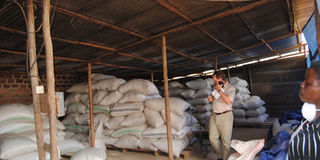Finding lucrative markets for agricultural products

The nature of storage of the produce after harvest is a crucial point especially for export markets. File photo.
What you need to know:
Most farmers in Uganda produce for both home consumption and market the surplus. But there are those that are purely commercial. But all these share a common problem: How and where to sell their produce.
Hannington Migadde is among the farmers who are tapping into the profitable market of agricultural products in Juba, South Sudan. He grows pawpaws on his one-acre piece of land in Luweero.
“There is a Ugandan trader in Juba who gives me twice what the middlemen in Kampala would give me for each pawpaw,” he says.
“For a pawpaw that I used to sell at Shs 500, he gives me Shs1,000 or Shs1,500. So, when they are in season, I simply call him up.”
Making connections
Clearly, he is making much more money than he did before, which he attributes to pure luck because this particular contact to Juba just came by looking for pawpaws. That is how they met. However, other farmers may not be as lucky yet they would like to enjoy more profitable returns on their agricultural products.
For example, bringing the products to markets in Kampala like Nakasero or Owino St Balikuddembe instead of selling them to middlemen at the farm may guarantee a farmer the kind of returns he is looking for.
But how does a farmer make this happen? If a farmer wants to take his or her produce to Nairobi or any other place in the country after hearing about the lucrativeness of the product (For instance, there has been word around the poultry-keeping communities in Kampala that eggs are fetching a better return in Mbale) how does a farmer successfully tap into this opportunity?
Do thorough market research
Much as you might get lucky, it would be foolhardy to simply load your product on a truck and drive towards Juba or Mbale just because you were told (or you think) that what you are selling is doing well there.
Aidah Nakimuli, who sells Irish potatoes wholesale in St Balikuddembe market that she gets from Kabale, says a farmer needs to compare the farmgate price and the wholesale price in the market.
“You can find that after factoring in things like transport, taxes and parking space, you will have Shs1m more in profits,” she says.
But Nakimuli says, a farmer should be willing to meet a given set of requirements to enjoy this extra income.
“For example, a farmer has to arrive at the market by 4am if you are to secure parking space, meaning that you spend the whole night travelling from your destination.
Consider costs
Most importantly, you must have a trustworthy contact; someone who will tell you that you need to wait a week before bringing your cassava if the market is saturated with this item which usually causes a price drop,” she explains.
Apart from not reaping as much as was anticipated when the market is saturated, a farmer can get stuck with their produce with no buyer(s). This will translate into more costs: spending on meals, accommodation, street parking, and paying more to the truck which you have kept waiting for an extra day.
Even worse, if your product is in the fresh food category like green pepper, carrots or cabbage, just a day spent without being offloaded may be enough to make it lose its appeal, which would result in a reduced price offer the next day.
To Nakimuli, these unpredictable factors, (even with a profit of Shs 1m or more at stake), may not be worth the risk and stress for a farmer, who has spent the last six months toiling on the farm, only to make a loss.
Take advantage of market information
Seeing that a trusted source of information is important when it comes to knowing what is going on in the market, FIT Uganda, an agribusiness consulting firm introduced an SMS/e-mail service. It provides market prices for 46 commodities across 34 districts on a weekly basis.
“We publish commodity prices for different areas such that a farmer (farmer groups which we deal with mostly) can decide where the best place to sell their product is,” says Jacob Olanya, an executive with the firm.
“We have contacts in all these districts and we get the prices of these commodities thrice a week; on Mondays, Wednesdays and Saturdays. Then on Tuesday afternoons, we send out this information to all the people on our mailing list—traders, farmers, middlemen and any other interested parties.”
Farmer groups are an added advantage
Indeed, there are several beneficiaries from FIT Uganda’s weekly market price information; farmer groups. While it may be hard for a farmer with an acre of, say, cassava, to fill a truck let alone move all the way to a certain district after communication that the price is much better there, it is easier for a group selling this commodity to accomplish this feat with the cost being fairly distributed to all of them.
CAPCA, Hunger Project, Trias and Veco are some of the NGOs that organise farmers into groups while urging them to utilise this commodity price information.
“FIT Uganda forwards us a list of information about the price of items like beans, maize and bananas which helps farmers to decide where to sell their product,” says Ronald Walusimbi, Capca’s marketing officer.
Get more from the produce
They also help these farmers sell to local exporters who export coffee. They encourage farmers to ensure their products have the quality needed in the export markets and teach them negotiation skills that help them get more out of their produce.
“When they understand the concept of dealing with local exporters, we believe that with time, they will be able to sell their products like maize and beans in lucrative outside markets like Juba, Nairobi or even countries like Italy on their own as farmer groups,” Walusimbi says.
For that farmer who is looking to earn more, it is possible with these tips and ideas.




